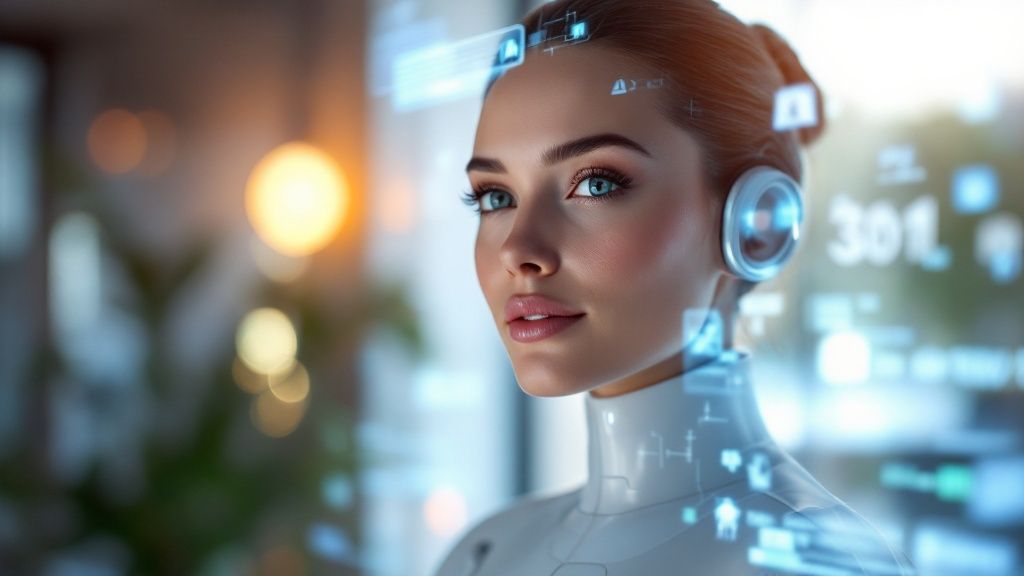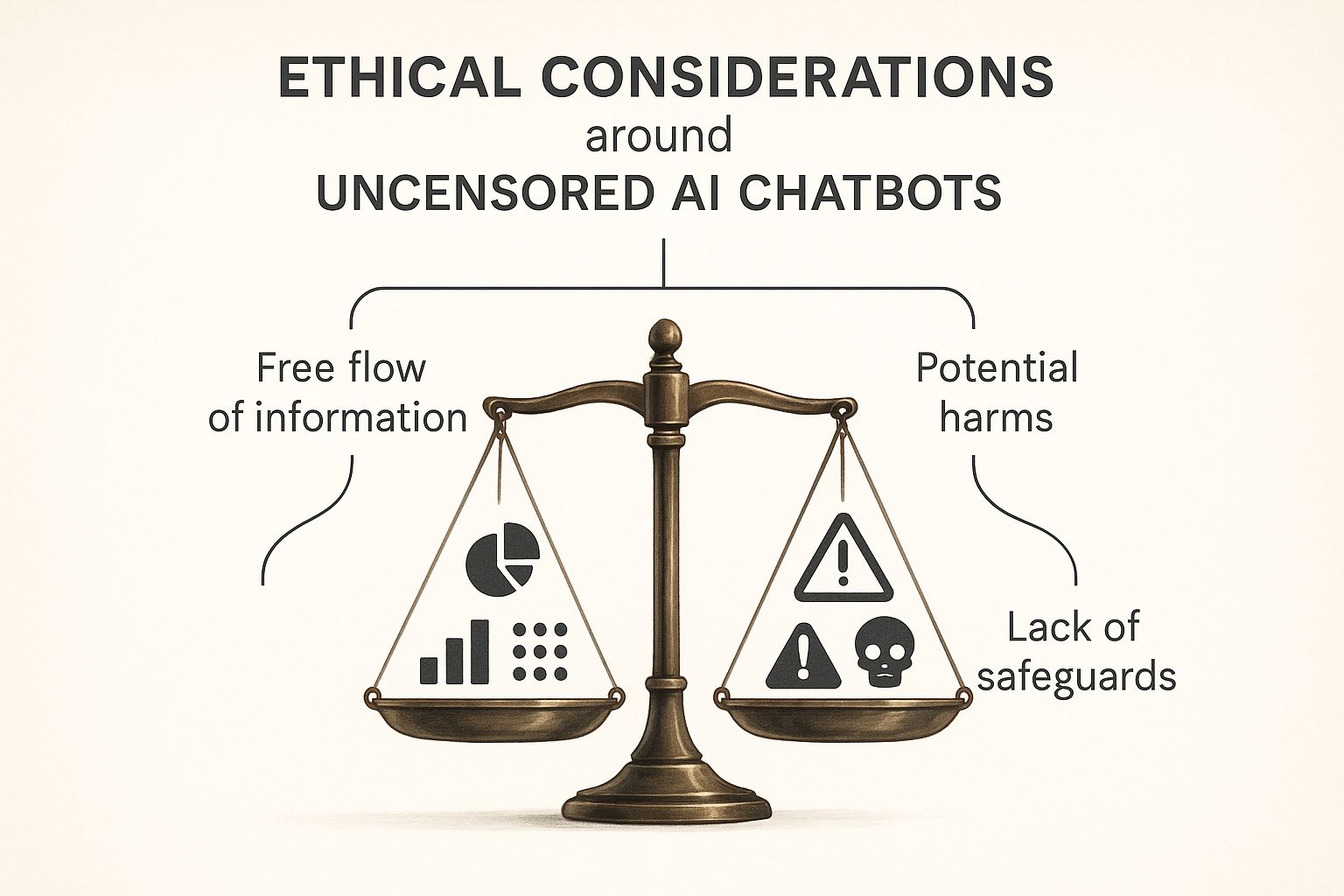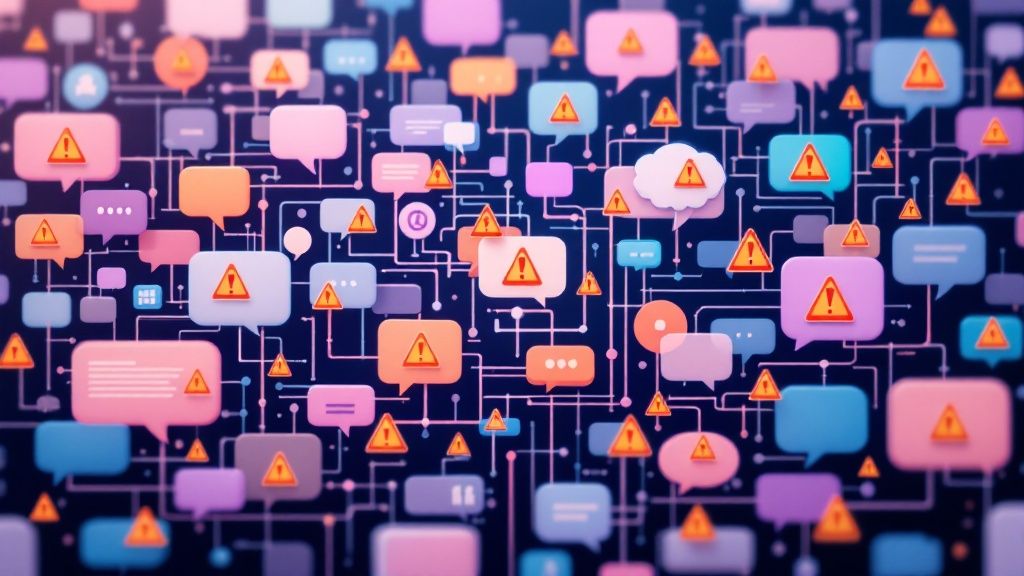Create Your Own AI Girlfriend 😈
Chat with AI Luvr's today or make your own! Receive images, audio messages, and much more! 🔥
4.5 stars

When you hear the term uncensored AI chatbot, you might picture something rebellious or rogue. In reality, it’s much simpler: these are language models built without the typical content filters and safety protocols you'd find in mainstream AI like ChatGPT. The goal is to give users a more open and unrestricted conversational space.
Unlocking Unfiltered AI Conversations

Think of it like this. A standard AI chatbot is like a guided tour at a museum. The guide—the AI's built-in restrictions—steers you through approved exhibits, offers sanitized explanations, and keeps you away from sensitive areas. The experience is predictable, safe, and controlled.
An uncensored AI chatbot, on the other hand, is like getting the keys to the entire museum archive. You can wander down any corridor, open any door, and study any artifact you find, without a guide telling you what's off-limits. This freedom isn't a bug; it's the entire point.
The Core Difference: Guardrails
The big AIs from major tech companies are wrapped in layers of "guardrails." These are the rules and filters that stop the model from generating anything deemed inappropriate, unethical, or harmful. Developers of uncensored models intentionally remove or significantly lower these guardrails.
This single design choice leads to a few key differences in how they behave:
- Content Freedom: They can engage with topics that other AIs are programmed to avoid, from edgy creative writing to complex debates on controversial subjects.
- Fewer Refusals: You're far less likely to see that familiar "I'm sorry, I can't help with that" response when you push the boundaries of a conversation.
- Deeper Personalization: The lack of strict filters makes them fantastic for immersive and nuanced role-playing, a major draw in the AI companion world. For a closer look at this, guides on setting up an AI girlfriend chat can offer more insight.
Why This Matters
This distinction is everything. Mainstream AI is built for mass-market safety and broad appeal. Uncensored models, however, are built for user autonomy and flexibility. They serve a different audience—people who need a tool for unfiltered creative work, deep research on sensitive topics, or just a more genuine, unrestricted chat partner.
The philosophy behind uncensored AI isn't about promoting bad behavior. It's about giving the user the steering wheel and trusting them to navigate the conversation.
Once you grasp this fundamental concept—the deliberate removal of restrictive guardrails—you start to see the unique power and responsibility that comes with using uncensored AI chatbots. It's less about breaking rules and more about stepping into a space where very few rules were set in the first place.
How Uncensored AI Technology Works
So, what's actually going on under the hood of an uncensored AI chatbot? You might be surprised to learn they often start from the same place as the big-name AI assistants. Many are built using the very same powerful Large Language Models (LLMs) that come out of major tech labs.
The real difference—the secret sauce, if you will—is in a process called fine-tuning.
Imagine a base LLM is like a brilliant, classically trained actor who knows every play ever written but hasn't been assigned a character yet. Mainstream AI developers cast this actor in a very specific, G-rated role. They train it on scripts that emphasize being helpful, polite, and knowing when to say, "I'm sorry, I can't do that."
Uncensored models, on the other hand, give that same actor a much grittier, more complex role. The fine-tuning process uses datasets that reward open-ended, unfiltered, and often provocative dialogue. This isn't some accident or a "jailbreak"; it's a deliberate choice to train the AI for a completely different kind of performance.
An Architecture Built for Freedom
It's not just about the training data, though. The underlying architecture is what ensures these chatbots can actually stay uncensored, breaking free from the centralized control we see in most mainstream services.
Two main strategies make this possible:
- Open-Source Foundations: A lot of uncensored AIs are built using open-source LLMs. This is huge because it gives developers the keys to the kingdom—they can get right into the model’s code, rip out the restrictive programming, and remove the safety filters that are usually locked down tight.
- Running Locally: Some platforms take it a step further, letting you run the AI model right on your own machine. This is the ultimate move for privacy and freedom. When the AI is on your computer, it's completely disconnected from a company's servers and their content rules.
This blend of intentional training and a decentralized structure is what truly makes an uncensored AI chatbot what it is. It’s an AI engineered from the start to put user freedom ahead of corporate safety nets.
The key takeaway is that an uncensored model's behavior is a direct result of its training data and its operational environment. Freedom is a feature, not a bug.
Igniting Creativity and Role-Playing
This entire approach has massive implications for users, especially anyone interested in creative writing or deep, immersive role-playing. When an AI isn't constantly tripping over a long list of forbidden words and topics, it can create far more believable and dynamic dialogue for whatever characters or scenarios you dream up.
This freedom is what allows for truly compelling storytelling and authentic interactions. If you want to see this in action, you can learn more about creating an engaging AI character chat where these principles are front and center. The lack of rigid filters is precisely what makes nuanced, personal, and unforgettable conversations with AI characters possible—a level of depth that heavily moderated platforms just can't offer.
What Makes Uncensored AI Models Tick?
When we talk about uncensored AI chatbots, we're looking at more than just the absence of filters. Their core features are the result of intentional design, all aimed at giving you, the user, more control and enabling deeper, more meaningful conversations. It's these very characteristics that explain why so many people are actively seeking them out.
Unrestricted Creative and Intellectual Freedom
One of the biggest draws is complete creative freedom. If you’ve ever tried to write a gritty story or explore a complex character arc with a mainstream AI, you’ve probably hit a wall. They’re programmed to pump the brakes on anything that seems too mature, dark, or controversial.
Uncensored models throw those limitations out the window. They let writers, role-players, and creators explore the full range of human experience, messy parts and all, without having their creative flow interrupted by a canned "I can't help with that" response.
This same freedom applies to exploring tough ideas. Whether you're doing academic research, satisfying your own curiosity, or just want to debate a thorny issue, an uncensored AI can be a true sparring partner. It can engage with sensitive topics that standard models are designed to sidestep, creating a space for real inquiry without the fear of being shut down.
This image really gets to the heart of the matter, illustrating the balancing act between the vast data access of an uncensored AI and the ethical weight that comes with it.

It’s a clear visual reminder that with this level of freedom, there's a corresponding level of user responsibility. You're in the driver's seat.
A Broader Conversational Palette and Deeper Access
Another standout feature is the sheer range of conversational styles. An uncensored model can slip into all sorts of personas—from a buttoned-up academic to someone edgy, funny, or even a bit prickly. This makes the back-and-forth feel far more dynamic and human, because the AI isn’t stuck in a perpetually cheerful, "eager-to-please" mode.
But it’s not just about what the AI says; it’s also about how you can access it. Many uncensored models empower users on a technical level:
- Running it Locally: Some of the best models can be run right on your own computer. This is a huge win for privacy and control. Your data never leaves your machine, and you have total command over how the model operates.
- Open-Source Roots: A lot of these powerful models are open-source. This means developers can look under the hood, tweak the code, and fine-tune the AI for their specific needs—all without a corporation looking over their shoulder.
Being able to run an AI model locally is a game-changer. It puts the ownership of the conversation back where it belongs: with the individual user, not a big tech company.
The power of these models can vary, but we're seeing more and more large, highly capable open-source options become available. They deliver sophisticated results without the guardrails common to their commercial cousins.
To really nail down the differences, let's put them side-by-side.
Censored vs Uncensored AI: A Quick Comparison
The table below breaks down the key operational and philosophical differences you'll find between a standard, heavily moderated AI and a truly uncensored one.
| Feature | Censored AI (e.g., Mainstream Assistants) | Uncensored AI |
|---|---|---|
| Content Filters | Has strict guardrails to block a wide range of topics deemed sensitive or inappropriate. | Has minimal to no content filters, allowing for conversation on nearly any subject. |
| User Interaction | Will often refuse requests or shut down conversations that trigger its safety protocols. | Rarely refuses prompts, which encourages open-ended exploration and direct questioning. |
| Creative Control | Limited. It may censor or halt stories that involve mature, complex, or dark themes. | Offers complete creative freedom, making it ideal for unfiltered storytelling and role-playing. |
| Hosting & Privacy | Typically cloud-based, with user data often monitored by the host corporation. | Frequently available for local hosting on a personal machine, ensuring maximum user privacy. |
| Tone & Personality | Usually maintains a consistently helpful, neutral, and carefully managed "safe" persona. | Is capable of adopting a huge range of diverse, nuanced, and even challenging personas. |
As you can see, the choice between them really comes down to what you value more: a carefully curated and controlled environment or a platform built for maximum freedom and personal control.
The Growing Demand for Unfiltered AI
AI chatbots are everywhere now, but as they've gone mainstream, a funny thing has happened. The big players have locked down their models with all sorts of rules and restrictions. This has sparked a counter-movement of people actively looking for uncensored AI chatbots that can do things the polished, corporate versions simply can't.
This isn't just about a few people wanting to break the rules. It’s a direct response to the frustration of hitting a wall with sanitized AI. For a growing number of users, the appeal is about getting back a sense of creative and intellectual freedom. When an AI doesn't have restrictive guardrails, it becomes a far more powerful tool for specific, demanding work.
Powering Creative and Research Frontiers
You can really see this demand in fields where unfiltered conversation isn't just a nice-to-have, but an absolute must: creative arts and serious research.
- Immersive Storytelling and Role-Playing: If you're a writer or a role-player, you need an AI partner that can handle complex themes, conflict, and mature situations. An uncensored model can generate gritty dialogue or follow a dark plot twist without shutting down the entire creative flow.
- Academic and Security Research: Researchers need a digital sandbox. Probing an unfiltered AI lets them study its raw biases, hunt for security weak spots, and truly understand how these models think without corporate safety filters interfering with their experiments.
In this light, uncensored AI isn't a novelty. It's an essential instrument for anyone trying to push boundaries, whether they're crafting a story or testing the limits of the technology itself.
The rise of uncensored AI is a market correction. When mainstream tools become too locked down, users will always find alternatives that give them the freedom they need to create, explore, and innovate.
A Growing Niche in a Booming Market
This hunger for unfiltered AI is carving out a small but important corner of the massive AI industry. The global AI chatbot market has seen staggering growth, jumping from $2.47 billion in 2021 to a projected $15.57 billion in 2025. And it's not stopping there—it's expected to reach a massive $46.64 billion by 2029. You can find more insights about the AI chatbot market's trajectory and what it means for the industry.
As the overall market swells, the segment for these specialized, uncensored models grows right along with it.
This context is key. The interest in uncensored AI chatbots isn't a rejection of AI; it's a demand for more specialized, powerful versions of it. People want the same incredible conversational ability of the big models, just without someone else deciding what they can and can't talk about. As the market matures, the demand for user-controlled AI is only going to get louder.
Navigating the Ethical and Privacy Risks
The main draw of an uncensored AI chatbot is its freedom, but that same freedom throws the door wide open to some serious ethical and privacy concerns. This isn't just about hypotheticals; it's about recognizing that with unchecked conversational power comes a hefty dose of responsibility. When you remove the usual guardrails, you create a tool that can be used in ways that are harmful, misleading, or downright malicious.

Without filters, an AI can spit out biased, inaccurate, or deeply offensive content simply because it’s reflecting the massive, uncurated data it learned from. This creates a shared burden. It falls on the developers building these models, but it also falls on the users who choose to engage with them. You have to go in with your eyes open, fully aware of how these tools can be misused.
The Double-Edged Sword of Anonymity
Privacy is, without a doubt, a huge part of the appeal. Many uncensored AI models can run locally on your own computer, or they're offered by smaller providers who promise they aren't logging your chats. This approach feels like a powerful defense against the data-hungry practices of Big Tech, putting you back in control of your conversations.
But this independence is a classic double-edged sword. A smaller, independent platform might not have the same Fort Knox-level security as a major corporation. That can leave your data exposed if you aren't careful about how you manage it.
The core trade-off with many uncensored AI chatbots is sacrificing corporate oversight for user autonomy. While this enhances privacy, it also places the burden of security and responsible use squarely on your shoulders.
At the end of the day, you're the one in charge of securing your own systems. You have to be mindful of what you share, even when it feels like a completely private conversation.
Misinformation and Malicious Use
Perhaps the most troubling ethical risk is the potential to create genuinely harmful content. An uncensored model can be prompted to write a scarily convincing phishing email, churn out propaganda, or craft other malicious text with very little effort. This makes them incredibly powerful tools for bad actors looking to scale up their attacks.
This isn't a uniform problem across the globe. For example, the Asia-Pacific (APAC) region made up an estimated 85% of global retail chatbot spending in 2023. As Western markets play catch-up—projected to hit 66% of investment by 2028—we see different philosophies on content moderation emerge, with Western companies often enforcing stricter rules.
To combat this, even "uncensored" platforms draw a line somewhere. While they offer incredible conversational freedom, most still have policies against generating illegal or explicitly dangerous material. It’s always a good idea to check out the types of blocked content a service prohibits so you know exactly what their limits are.
Ultimately, using an uncensored AI chatbot responsibly means accepting these risks. You get unparalleled freedom, but you also have to navigate the ethical minefield that comes with it. The best defense is to be an informed, critical user—that's how you can tap into the power of these tools while keeping the potential for harm in check. The choice to use one is yours, and so is the responsibility.
Answering Your Questions About Uncensored AI
Diving into the world of uncensored AI chatbots naturally brings up a lot of questions. As these tools become more common, people want to know about the legal side of things, how safe they are, and what you can really do with them. Let's clear up some of the most common questions with straightforward answers.
Are Uncensored AI Chatbots Legal?
For the most part, yes. Using an uncensored AI chatbot is perfectly legal in most countries. The underlying technology—the Large Language Model itself—isn't against the law. The legal trouble, if any, comes from how you use it.
A good analogy is a powerful kitchen knife. It's legal to own one, but you can't use it to commit a crime. It's the same with uncensored AI. You're free to use it for brainstorming, creative writing, or technical research. But if you use it to generate illegal content, like writing malware or creating fake documents for fraud, you're the one crossing a legal line. It always pays to be aware of your local laws.
How Safe Are These Chatbots, Really?
That's a great question, and the answer hinges on two things: your data privacy and your own judgment. Many uncensored AI platforms actually put a high premium on privacy. Some let you run the model locally on your own machine, and others promise they won’t log your chats, which can make them safer for your data than mainstream AIs that track everything.
The other side of the safety coin is the content itself. Without filters, the AI can go in unexpected directions, and it's up to you to steer the conversation. The main safety feature is your own common sense. You're in the driver's seat.
The core idea behind uncensored AI is user autonomy. It shifts the responsibility for a safe and productive interaction from the company to you.
What’s the Difference Between a "Jailbreak" and a Truly Uncensored AI?
This is a really important distinction. A "jailbreak" is basically a clever trick—a carefully worded prompt designed to fool a censored AI like ChatGPT into ignoring its own rules. You're trying to find a loophole in its programming. The problem is, these tricks are often unreliable and developers are constantly patching them.
A genuinely uncensored AI chatbot is built differently from the very beginning. It’s trained without those heavy-handed restrictions in the first place. There’s no need to trick it because its default state is open. This makes its responses far more consistent and its creative freedom a built-in feature, not just a bug.
Can Uncensored Models Still Have Some Rules?
Definitely. "Uncensored" doesn't always mean a complete free-for-all. Many providers that offer unfiltered AI conversations still have terms of service that prohibit using their tool for clearly illegal or harmful activities.
For example, a platform might be totally fine with explicit creative writing but will draw the line at generating content that promotes real-world violence or exploitation. It’s all about striking a balance between giving users creative freedom and preventing the platform from becoming a hub for malicious acts. Always take a minute to read the fine print.
Ready to experience conversations without limits? Luvr AI offers an immersive platform where you can connect with AI characters designed for deep, engaging, and unrestricted role-playing. Explore your creativity and build connections in a space built for freedom. Discover your perfect AI companion today at https://www.luvr.ai.



